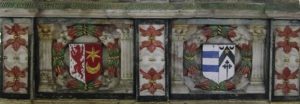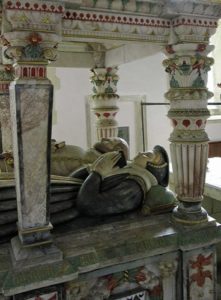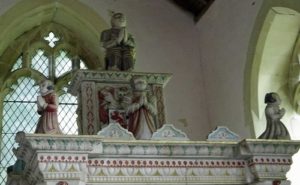We spend a day visiting some of the churches in rural Lincolnshire as husband was wanting to experiment taking pictures using his new camera. We found a mention of this church in England’s Thousand Best Churches by Simon Jenkins. We read his description of the glorious family monuments and added it to the list.
It is in the depths of the Lincolnshire countryside on a narrow unclassified lane to the north off the A46 to the north east of Lincoln, between Dunholme and Faldingworth.
It is tucked away among the trees with a few scattered farms around. There had been a Viking settlement here and a village is mentioned in the Domesday book, with 16 families. In medieval times there had been a thriving village which was probably almost deserted by Tudor times. The St Paul Family were large land owners who settled in the area and built a grand mansion here in 1500, replaced by a bigger and better one in 1606.
The church is a small building with a low square tower at the west end. The Gothic windows in the nave have carved heads at the base of the arches. It was probably begun in the 12thC. The nave is 13thC. The chancel was enlarged in 1600 to house the grand family tombs.
The nave is plain with simple pews and a small piano. At the back of the church, under the tower is a hexagonal stone font with carvings of shields, heads and foliage on the sides. There is little to hold the interest. Pass through quickly and head past the altar to the magnificent six poster alabaster bed tomb with the recumbent bodies of Sir Thomas St Paul who died in 1582 and his wife Faith Grantham. Sir Paul’s head rests on a helmet with an elephant and castle which was the family crest. Other engravings of them can be seen around the tomb. Round the top of the canopy are the kneeling figures of six of their children with the bust of their heir, Sir George on the top of an altar in the centre.
Sir Thomas was an MP and served as Sheriff of Lincolnshire. Through his marriage he had connections to many of the most powerful families in the county and the tomb is covered with family coat of arms. Around the base of the bed are shields with a red lion rampant on the left side and two magpies with a wide black band and another magpie underneath. These are surrounded by carved wreaths with apples and green and red foliage. Above is a beautifully carved canopy.
Sir George is in armour picked out in gold. He has a closed book in one hand and a long sword in the other. His wife is dressed in black with gold trimming at her cuffs and round her head dress.
The chancel has been extended to the north and there is another small altar, with a carved stone tombstone in the floor to George Brownlow Doughty who died in 1743.
On the north wall is the massive wall tomb of Sir George de Paul, son of Sir Thomas, who was the wealthiest and most influential member of the family. He wearing armour and is depicted lying on his side with his head propped on his hand with a pillow under his elbow. In his other hand is his sword. Details on his armour are picked out with red and gold. Below him is his wife, Frances Wray, who came from nearby Glentworth (see review). She is also shown lying on her side and holding a book. She is dressed in a black farthingale with white ruff . The two figures are set in an arch which has red and white flowers set in black squares on the underside. On the back is a memorial plate to them. Dark and pale alabaster pillars support a portico with a crest above.
At the base of the tomb is a small figure of a girl. This is Mattathia, their only child who was born after 12 years of marriage but died before she was two. She is wearing a black dress with a beautifully picked out white lace head dress and collar. She is buried under the opposite wall and there is a brass plate commemorating her there. On either side of her are small putti, naked small boys. One is in poor condition but the other has a skull under his foot.
After the death of Sir George, Francis Wray married Robert, Lord Rich. He bought the Earldom of Warwick from James I for £10,000. Their memorial is on the north wall to the left of Sir George’s tomb. Their heads are set in a roundel with Frances wearing her countess’s coronet. Above is the Warwick crest with coronet. Below is a plaque with an inscription.
The church is no longer used and is cared for by the Churches Conservation Trust and is always open. It is well worth finding and the family tombs really are amazing. There is some parking on the edge of the road outside. It can be tied in with visits to Stow Minster, St Edith’s Church at Coates and St Michael’s Church, Glentworth (see reviews).
There are more pictures “here.”:http://wasleys.org.uk/eleanor/churches/england/lincolnshire/lincolnshire_four/snarford/index.html










